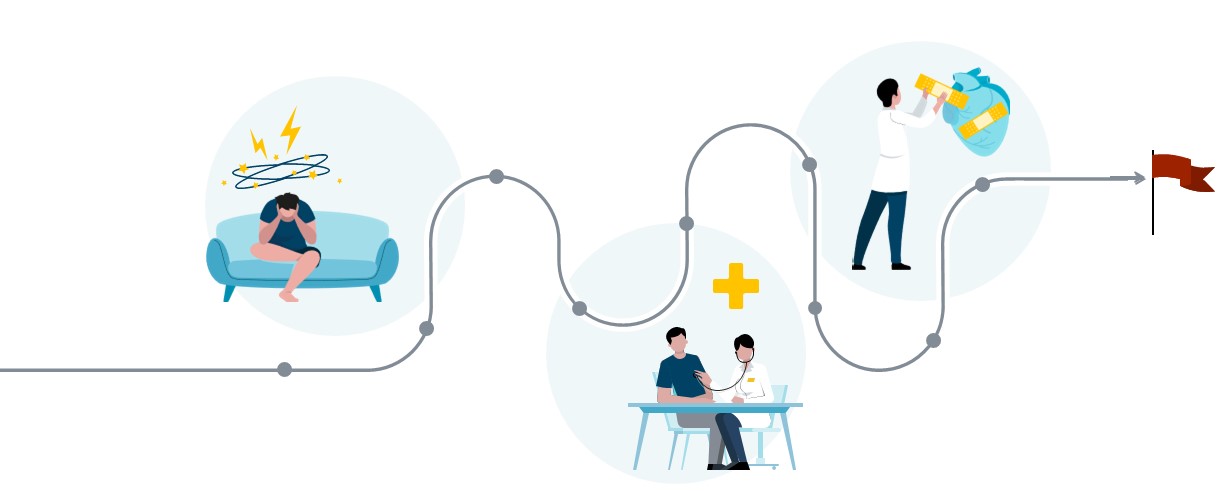Understanding the individual patient experience and their needs is key to improving the quality of care.
A patient journey analysis can be used to describe the entire journey that a person goes through as a patient from the time they first notice health symptoms or concerns through to treatment and recovery.
The aim of the GIM Patient Journey is to support you in exploring complex relationship patterns between patients, the course of their illness, the health care professionals involved and other influencing factors such as family or online health information and communities.

For whom is a patient journey analysis relevant?
Patient journey analysis is a proven method for improving healthcare and increasing patient satisfaction. It is suitable for healthcare organisations from hospitals and insurance companies to research institutions and patient advocacy groups.
Pharmaceutical companies in particular can use the patient journey to understand the treatment process of their medicines: including the prescription, purchase and use of the medicines. Fundamentally, the analysis is valuable for identifying barriers to medication adherence and providing better educational materials.
We have already used the GIM Patient Journey in different areas.
The most important fields of application are:
- Communication development
- Product positioning
- Target group definition and segmentation
- Sales force strategy
- Media planning
- Typing
How we explore your patient journey
Our patient journey is based on qualitative methods to uncover underlying structures, emotions and needs of those affected. In addition to classic qualitative market research approaches, we use biographical narrative interviews, ethnographic tools, preparatory (online) diaries and analytical visualisation of the patient's medical history.
The patient journey is a complex process that involves various stakeholders, medical specialities and services. Our claim is a holistic 360° approach. In addition to patients, we also include the opinions of other stakeholders such as relatives and healthcare professionals. Close collaboration with medical staff and other healthcare providers enables us to find practical solutions.
Holistic 360° approach
The patient's perspective is invaluable. Only they can offer first-hand insights into their treatment process, their experiences and their needs. Direct patient consultation is essential to understand the patient journey from the patient's perspective and ensure their voices are heard.
Medical professionals, including doctors, nurses, pharmacists and others, on the other hand, have a deep understanding of medical procedures. Only they can offer insights into the challenges and opportunities in healthcare. Their perspectives are critical to improving the quality of healthcare.
Project phases of the GIM Patient Journey
Our GIM Patient Journey consists of three project phases. The preparation phase, the analysis phase and the results phase. Each phase is changeable and is individually customised by our experts for a new project and adapted to the needs of the respective client.
The following description serves as an initial orientation and shows how a joint project could proceed.
1) Preparation phase: in the preparation phase, we first define the objective of the analysis and determine which specific questions need to be answered. In the second step, we select which group of patients is relevant for the analysis. At the end of the phase, we collect relevant data on the patients, for example through interviews or surveys.
2) Analysis phase: in the analysis phase, we use the collected data to map the patient journey and identify different touchpoints a patient has during the treatment process. The mapping enables us to identify weak points and opportunities in order to subsequently derive optimisation potential.
3) Results phase: based on the results of the data analysis, we derive recommendations for measures to improve the patient journey. We document the analysis and the resulting recommendations in a comprehensive final report, which we present to you and your team and make available for further use.
Advantages of a patient journey analysis
Researching the patient journey helps you as a healthcare provider to better understand patients, anticipate their needs and optimize the quality of care. By creating a realistic picture of a patient's care situation, we can identify which stages of treatment present the greatest challenges and where improvements can be made.
In short, a patient journey analysis helps to identify bottlenecks and challenges in the healthcare system and develop solutions to optimize the patient experience as well as collaboration between different stakeholders.
Your contact
We will gladly advise you.

Patricia Blau
Corporate Director

Doris Fuchs
Senior Research Director

